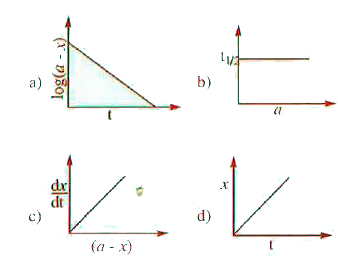Rate of a reaction is the change in concentration of reactant or product per unit time.what does the slope of the graph represent, variation In the concentration vs time for a zero order reaction?Solution in Malayalam
Step by step video & image solution for Rate of a reaction is the change in concentration of reactant or product per unit time.what does the slope of the graph represent, variation In the concentration vs time for a zero order reaction? by Chemistry experts to help you in doubts & scoring excellent marks in Class 12 exams.
Topper's Solved these Questions
Similar Questions
Sanger’s reagent is used for the identification of_______.
03:16View SolutionWhich category of the synthetic detergent is used in tooth paste?
03:03View SolutionStatement: Concentration of the reactant and product does not change with time at equilibrium for a chemical reaction.
Explanation: The rate of a reaction is zero at equilibrium.View SolutionFor a zero order reaction, the plot of concentration of a reactant vs time is (intercept refers to concentration axis)
03:03View SolutionAssertion : concentration of the reactant and product does not change with time at equilibrium for a a chemical reaction. Reason : The rate of a reaction is zero at equilibrium .
04:27View SolutionFor a zero order reaction, the plot of concentration of a reactant vs time is (intercept refers to concentration axis)
05:31View SolutionThe reaction A+B→ products is first order in each of the reactants.
(a) How does the rate of reaction change if the concentration of A is increased by factor 3 ?
(b) What is the change in the rate of reaction if the concentration of A is halved and concentration of B is doubled ?03:52View SolutionFor a zero order reaction, the initial concentration of the reactant =[A]0 and after time 't' from the initiation of the reaction, the concentration =[A] . What will be the nature of the graph of '[A]' vs 't,
01:49View SolutionWhat is slope of the graph of log[A] vs t for a first order reaction, where [A] is the concentration of reactant at any time t during the reaction.
05:25View Solutionplot a graph of reaction -rate vs concentration of the reactant for a fist order reaction.
03:14View SolutionWhich of the following graphs represent a first order reaction (a=initial concentration of reactant, x=concentration of reactant consumed, t=time)
 05:25View Solution
05:25View SolutionA : At equilibrium concentration of the reactant and product does not change with time for a chemical reaction.
R : The rate of reaction is zero at equilibrium02:01View SolutionWhich of the following graphs represent a first order reaction (a=initial concentration of reactant, x=concentration of reactant consumed, t=time)
01:46View Solution(A) Units of rate of reaction are independent of order of the reaction
(R ) Rate of reaction is the change in concentration of reactants in unit time02:23View SolutionRate of a reaction is the change in concentration of any one of the reactants or any one of the products in unit time. Define order of a reaction.
03:13View SolutionPlot a graph showing variation in the concentration of reactants against time for a zero order reaction.
01:41View Solution

